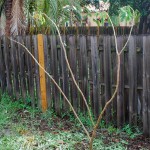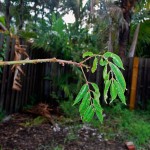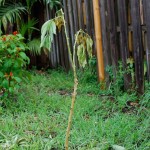Like most people, our house backs up onto another house’s back yard. We each have a backyard fence, and there’s about an 8-inch no-man’s land in between the fences. And that gap is being colonized with some plants, both native and non-native. One of the natives is actually quite a desirable tree: a Gumbo-Limbo (Bursera simaruba). According to the local wisdom here in south Florida, this tree is so easy to grow, you can just break off a branch, set it in the ground, and the branch will grow into a tree.
The problem is, the tree was not only growing very tall and slender—at least 20 feet—it was also growing in the wrong place: straight up into our phone and power lines. With Friday’s storm fresh in my mind, I decided it was time to take care of the situation, and at the same time test the truth of that local wisdom.
In my Florida Master Naturalist classes, this local lore was even elevated to an evolutionary strategy: the idea is, because the tree evolved in an environment with frequent hurricanes, it “chose” to be breakable under pressure of strong winds, but the broken parts, because they’re able to regrow, will allow the plant’s genes to survive. This is the opposite strategy of the mighty oak, which evolved incredible strength to try to resist the wind. The problem with that strategy of course, is that there’s always a wind that’s bigger and stronger than your wood. I’m not sure what kind of tree my neighbor’s was, but it certainly seemed to be trying to emulate the oak rather than the gumbo-limbo, but the “mere” 50-mph winds showed that it didn’t really have the genetic material to do so…
Anyway, back to my backyard. As any photographer will tell you, if you’re not sure which is the correct exposure, it’s a good idea to “bracket” your shots, exposing one “too little,” one “just enough,” and one “too much.” I decided to apply that wisdom to my gumbo-limbo experiment, planting one little branch, one medium branch, and one large branch. Here are the three contestants:
- The large tree is about 6 feet tall, with 4 largish branches; the medium tree is about 4 feet tall, with only the one branch, and the small tree is about 2 feet tall. I applied rooting hormone to 2 of the 3 branches (I forget which one I forgot!), but I’m not sure it’s required, given this tree’s reputation. I also watered them in pretty well, which, of course, is necessary for any transplantation, let alone a rootless one like this one. We’ll see if any of them take off.
As I found out in the front yard with a fully rooted tree, gumbos tend to drop their leaves when transplanted, so I shaved most of the leaves off, leaving only a few to provide what photosynthesis they might until the branch either does or doesn’t decide to set up a root system. And when I got up this morning, I discovered an unexpected but welcome bonus, courtesy of the rainy season: with the inch and a quarter of rain we got before dawn, not only do I not have to water them again today, but the raindrops made for a prettier picture than I’m normally capable of!
I’m rooting for these trees to make it (yes, sadly, pun intended), but even if they don’t, I consider this time well spent. I’ll have learned something about what “they say” (ie, whether or not you can just break off a branch and plant it), and moreover, my phone and cable lines are clear now in the event of a storm.
If I happen to get a few extra trees into the bargain, well, I’ll count myself fortunate.




Wonderful to return to read your musings, Ben. I’m impressed by your faithful entries, and your sense of joy in discovery. Thank you for sharing your enthusiasms. Eager to hear how your newly transplanted gumbo-limbos fare. J